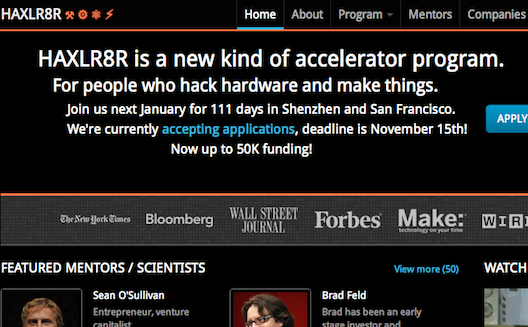Is building hardware in China the secret to crowdfunding a huge seed round?


Devices are having a moment, and so is HAXLR8R. The hardware-focused startup accelerator, based between San Francisco and Shenzhen, China, has fostered the development and acceleration of over 30 companies since March 2012, and has earned combined revenues and investments of tens of millions of dollars. (Disclosure: Wamda CEO Habib Haddad is a mentor in the HAXLR8R program).
Crowdfunding has been a significant part of HAXLR8R’s meteoric success; its many $300,000+ USD Kickstarter campaigns attest to a carefully-crafted crowdfunding model, designed to fully harness the potential of this type of investment. Co-founder Cyril Ebersweiler emphasized, on a phone call with Wamda from his space in Shenzhen, the importance of having the concept for a potential piece of hardware “nailed down,” with the design and manufacture of the product completely lined up, before crowdfunding can be broached.
This approach has led to crowdfunding successes for several HAXLR8R companies, including Hex (a remote-controlled robot drone which raised nearly $564,000 USD), Spark (a chip that Wi-Fi-enables any device, which raised nearly $569,000 USD), and Nomiku (a device allowing home cooks to use the sous-vide technique, which raised $586,000 USD). None of HAXLR8R’s companies have made a dent in the all-time crowdfunding record of $10.2 million USD set by Pebble, the smartwatch, another hardware innovation, but these numbers are significant nonetheless.
Product manufacture, not coincidentally, happens to be HAXLR8R’s specialty. The accelerator seems to have achieved with flying colors its early goal, as reported by Wamda last January, of bringing in foreign startups with an eye towards streamlining the manufacturing processes and supply chains, so as to bring innovative new hardware to market “as fast as possible.”
The burgeoning manufacturing hub of Shenzhen, Ebersweiler says, has “everything that makes life easier. Every electronic part [a maker could possibly need] is available downstairs in the electronics market… This means you can do a lot more iteration and prototyping on products.” Shenzhen also has very diverse and developed manufacturing infrastructure. The combination of raw materials and the necessary factories “means that people can build a product that has been thought out well.”
HAXLR8R’s base in China, with its conveniently located supply lines and manufacturing infrastructure, is luring entrepreneurs away from other hardware accelerators, whose ties to China may seem comparatively tenuous. The founders of Petcube, another HAXLR8R alum, told PandoDaily’s Hamish McKenzie that they “considered Boston’s Bolt, whose partnership with Dragon Innovation gives it connections to China’s factories and supply chain, but ultimately decided they wanted to base themselves in Shenzhen… while they got the product ready to ship.” Lebanese maker Hind Hobeika also chose China as the place to manufacture her gadget Instabeat, though she's not involved in HAXLR8R.
A crucial part of any crowdfunding campaign is the reward, the prize a startup agrees to send people in exchange for certain amounts of money. With social entrepreneurship campaigns, or campaigns to support artists, these rewards are usually just a token of appreciation rather than something substantive. But in the case of hardware, a crowdfunding campaign gives people the chance to not only buy a sexy new gadget, but to get in on the ground floor of something that might disrupt an industry. Campaigns like Spark, Hex, and Nomiku may have been successful because they were able to capture the drama of crowdfunding and apply it to a more traditional buy-sell product exchange model.
But, Ebersweiler says, the fact that people who donate to this kind of crowdfunding campaign are buying a product, rather than investing in an idea, “can be a trap.” The promise of Kickstarter and other crowdfunding sites has always been about starting a company, or buying into an idea, rather than delivering a very specific product. As a result, he goes on, “there have sometimes been gross misunderstandings about what the physical product is and when it’s available, [misunderstandings for which] the entrepreneur is not necessarily to blame.”
Ebersweiler also remains clear-eyed about the extent to which crowdfunding might change the relationship between entrepreneurs and traditional equity investment. Crowdfunding “doesn’t replace traditional investment; not every project, product, or team is willing to build a scalable startup.” For some people, he says, it’s enough to kickstart a nice bit of cash from one product, but these people “won’t be willing to scale their operations and provide returns to their investors.” Crowdfunding, if successful, “could bypass angel rounds [of investment], allowing startups to jump into the next level.”
HAXLR8R is smart to keep its crowdfunding success in perspective – this investment strategy is hardly the panacea it’s being touted as in some outlets. But it’s impossible to ignore the significant investment sums that have been achieved by HAXLR8R’s companies from smart crowdfunding campaigns. No doubt the next class of makers to go through HAXLR8R – people Ebersweiler says are working on robotics, connectivity devices, toys, and “stuff in biohacking, bionics, new stuff that is borderline crazy” – are hoping they might hit the crowdfunding mother lode, perhaps even challenging Pebble’s record. Given HAXLR8R’s track record, one of them just might.
Wamda CEO Habib Haddad invites those interested to contact him regarding his mentorship duties with HAXLR8R. He can be reached at habib@wamda.com.


